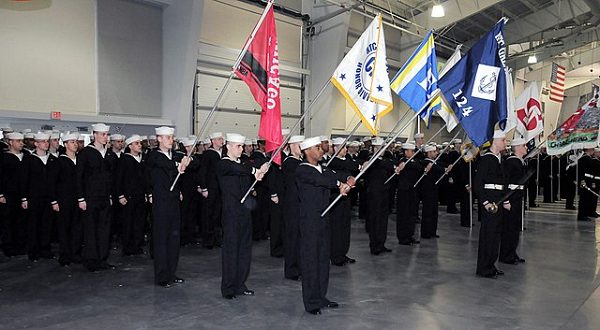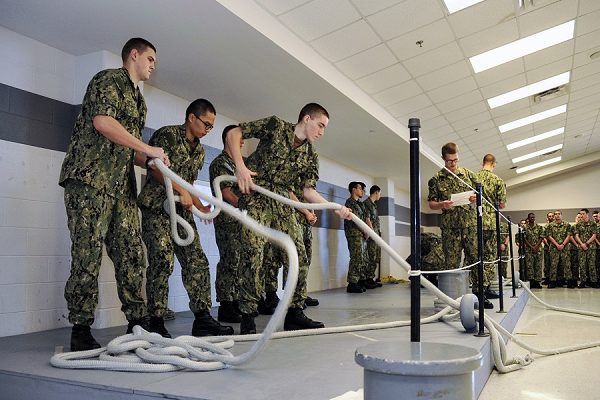If you are about to embark on your Navy career, you might wonder what happens after Navy boot camp graduation.
Once you finish boot camp, you will experience graduation before attending more training.
When your training is complete, you transition to your first permanent duty station.
Related Article – Is Navy Boot Camp Hard?
Table of Contents
What Happens Right After Navy Boot Camp Graduation?

What happens after Navy boot camp is an event called Pass-In-Review.
Pass-In-Review is a ceremony that recognizes the efforts it took to complete Navy boot camp.
This ceremony is held on Thursdays.
Recruits leave for their technical school rather quickly after Navy boot camp. However, most new sailors do have the liberty to go off base after the Pass-In-Review. They also enjoy off-base liberty on Friday.
However, graduating sailors are restricted in what they wear, how far they travel, and how they conduct themselves off-base.
If new sailors are attending A School at the Training Support Center in Great Lakes, they check into school on Friday morning. Afterward, they’re free to enjoy time with friends and family off base.
Sailors who go straight to A School somewhere other than Great Lakes will leave on Saturday.
The sailor is briefed about their personal schedule and on and off-base liberty rules before graduation day.
Related Article – US Navy Boot Camp Graduation Gift Ideas
Navy A School Explained
Another event that happens after Navy Boot camp is departing to Navy A School.
A School is the training you receive that relates to the job you have in the Navy.
At this school, you learn entry-level skills so you can jump into your new job and begin your on-the-job training.
While most new sailors leave the recruit training command and go straight to A school, some have additional training before A school.
Your rate, or Navy occupation, determines which school you attend.
At the beginning of your A school, you will not be able to leave the base. However, you will have base liberty.
Base liberty means you can go anywhere you want, for the most part, while on base, not on duty, and before curfew.
However, after that initial timeframe, sailors can leave the base for off-base liberty.
Keep in mind the difference between leave and liberty. Leave is the time you earn off, like vacation time. On the other hand, liberty is how much freedom you have during your time not on duty.
Even when you can go off-base, you still have a curfew.
Your rate, Navy job specialty, determines which school you attend.
Related Article – ASVAB Scores For Navy Jobs
What Happens After Navy Boot Camp: A School Options

The required amount of initial training is what determines how long you are a school will be.
Technician (ET)
For example, if your Navy job is to be an Electronics Technician (ET), the A School location is at Great Lakes, Illinois.
If you are at this A school, you learn basic electronic skills, fiber optics, and how to troubleshoot problems, to name a few topics.
The apprentice technical training is 11 weeks, and the following A school is 19 weeks in length.
Fire Control Technician (FT)
However, if you will be a Fire Control Technician (FT), the A School occurs in Groton, Connecticut.
Before A School, new sailors attend Basic Enlisted Submarine School for 8 weeks before the 18-week-long technical training.
While the first school is all about submarine systems, the technical training covers electronics and computer technology basics.
As a Fire Control Technician, you learn the maintenance and operation of the electronic equipment related to submarine weapons systems.
Operations Specialist (OS)
Also, if your Navy job is as an Operations Specialist (OS), you will attend school at Great Lakes, Illinois.
The A Technical School for this position is 10 weeks in length.
Also, during this course, you’ll learn radar operation, tracking and interpretation, vector analysis, and chart and course plotting, to name a few.
Related Article – Navy A School Locations
What Happens After A School?
After Navy A School, you have the option to take 10 days of leave before you head to your first permanent duty station.
However, there are some situations when you have more leave available, especially if you are going overseas.
There are several duty options and locations after A School.
Also, different deployment schedules depend on your rating.
For instance, some sea/shore rotations have a number such as 36/36. This means you have 36 months of sea duty and 36 months onshore.
The 36/36 rotation is standard, but remember, many ships and submarines spend a good deal of time docked. Therefore, you are not necessarily on the open water the whole time.
Some sailors, depending on their job, have a different rotation based on Navy needs.
Also, there are three different duties.
Shore duty is on land and often includes time spent at schools that last longer than 18 months. There are other duties on land, including remote or overseas shore.
Neutral duty is also land-based and includes time spent at schools that have a shorter duration.
Furthermore, there are various sea duty options. These options include sea duty when the vessel is away from its port and nonrated sea duty when the vessel is in port.
Related Article – 12 Best Navy Bases For Families, Singles, and Overseas
Conclusion
Once you graduate from Navy boot camp, there is still more training.
Some new sailors check into their A School the Friday morning after graduation (on Thursday). However, they’re free to enjoy off-base liberty until Saturday night after this.
Other new sailors leave for A school on the Saturday morning after graduation to attend technical school away from Great Lakes.
Once a sailor completes A school, they may take leave before transitioning to their first permanent duty station.
Some jobs have a 36/36 rotation of months at sea vs. on land. Sea-intensive rates, however, may have a 48 to 60 month sea duty obligation before eventually evening off to 36/36.
However, the sea and land rotation depends on the Navy’s needs and your particular job.
References:
See Also
What To Bring To Navy Boot Camp
Navy Signing, Enlistment, and Reenlistment Bonuses
- Replacing Dog Tags: 6 Things You Need to Know - June 28, 2024
- Navy OAR Test Study Guide - June 24, 2024
- 10 Best Sniper Movies of all Time - June 20, 2024
Originally posted on February 16, 2021 @ 1:23 pm
Affiliate Disclosure: This post may contain affiliate links. If you click and purchase, I may receive a small commission at no extra cost to you. I only recommend products I have personally vetted. Learn more.

